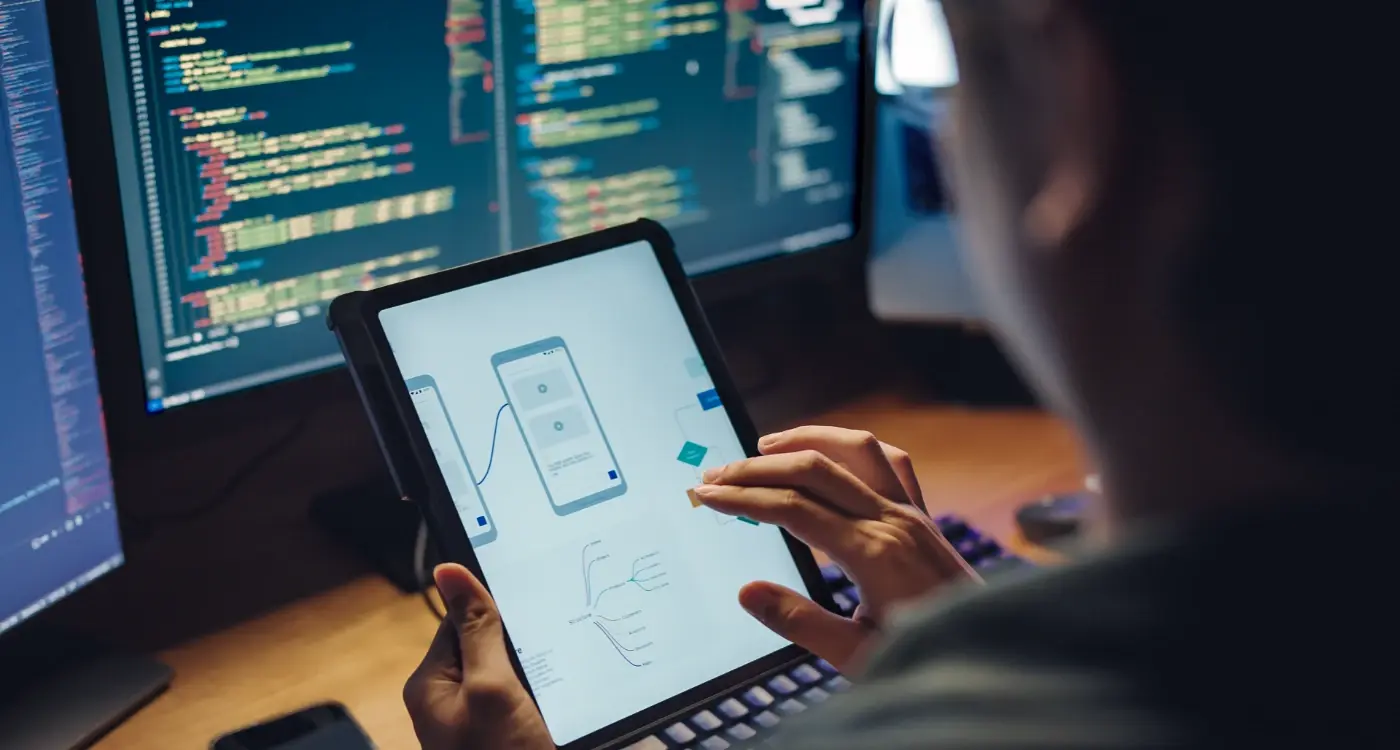What Version Control System Should I Use For My Mobile App?
Every mobile app developer faces the same nightmare: that sinking feeling when you realise you've accidentally broken something that was working perfectly yesterday. Or worse—when your teammate has made changes that completely conflict with yours. Without proper version control, building a mobile app becomes like trying to solve a jigsaw puzzle whilst someone keeps moving the pieces around.
Version control isn't just about backing up your code; it's about maintaining your sanity during development. When you're building a mobile app, you'll have dozens of files that need to work together perfectly. One small change can break everything, and without a proper system to track those changes, you're essentially flying blind.
The question isn't whether you need version control for your mobile app—it's which system will serve you best throughout your development journey
This guide will walk you through everything you need to know about choosing the right version control system for your mobile app project. We'll explore Git (the industry favourite), look at alternatives, and show you how to set up workflows that actually make sense. Whether you're a solo developer or part of a team, getting this decision right early on will save you countless headaches down the road.
What is Version Control and Why Does it Matter
Let's start with the basics—version control is like having a detailed diary for your mobile app's code. Every time you or your team makes changes to the app, version control keeps track of what changed, who changed it, and when it happened. Think of it as a safety net that catches you when things go wrong.
I've worked on projects where developers accidentally deleted important files or introduced bugs that broke the entire app. Without version control, these situations would be nightmares. With it, you can simply roll back to a previous working version and carry on with your day.
Why Mobile App Development Needs Version Control
Mobile apps are complex beasts. You're dealing with different operating systems, screen sizes, and device capabilities all at once. When multiple developers work on the same project, things can get messy quickly. Version control solves this by managing all the chaos behind the scenes.
Here's what version control does for your mobile app project:
- Tracks every change made to your app's code
- Allows multiple developers to work on different features simultaneously
- Prevents conflicts when team members modify the same files
- Creates backup points you can return to if something breaks
- Documents the history of your project's development
Without version control, you're essentially working without a safety net. One mistake could set your project back weeks or even months.
Understanding Git—The Industry Standard
Right, let's talk about Git. I've been using it for mobile app development for years now, and honestly, once you get the hang of it, you'll wonder how you ever managed without it. Git is what we call a distributed version control system—which sounds fancy but really just means everyone on your team gets their own complete copy of your project's history.
What makes Git special is that it tracks every single change to your mobile app code. Every line you add, every bug you fix, every feature you build—Git remembers it all. This is brilliant for mobile app development because you're constantly tweaking things, testing on different devices, and collaborating with designers and other developers.
Why Mobile App Teams Love Git
Git handles the chaos of mobile development beautifully. When you're working on an Android app and your colleague is fixing iOS bugs, Git keeps everything organised. You can work on separate features without stepping on each other's toes, then merge your changes together when you're ready.
Start using Git from day one of your mobile app project, even if you're working alone. You'll thank yourself later when you need to roll back a breaking change or figure out when a bug was introduced.
The best part? Git works offline, so you can code on the train, in a coffee shop, or anywhere else inspiration strikes. Your development tools don't need an internet connection to track changes.
Alternative Version Control Systems for Mobile Apps
Look, I'll be honest with you—Git dominates the mobile development world for good reason. But that doesn't mean it's your only option, and sometimes it pays to know what else is out there. I've worked with teams who've used different systems over the years, and whilst most eventually migrate to Git, there are legitimate reasons why you might consider alternatives.
Subversion (SVN) is probably the most common alternative you'll encounter. It's been around forever and some larger organisations still use it for their mobile projects. SVN works differently to Git—it's centralised rather than distributed, which means there's one main repository that everyone connects to. This can actually be simpler for smaller teams who don't need Git's complexity.
When Alternatives Make Sense
Mercurial is another option that's similar to Git but with a gentler learning curve. If your team struggles with Git's complexity, Mercurial might be worth considering. Perforce is popular in gaming and larger enterprises—it handles massive files brilliantly, which can be useful for mobile apps with lots of assets.
That said, I'd recommend sticking with Git unless you have a compelling reason not to. The tooling, community support, and integration with platforms like GitHub and GitLab make it the practical choice for most mobile development projects.
Setting Up Your First Repository
Right, let's get our hands dirty and create your first Git repository for mobile app development. I'll walk you through this step by step—it's actually much simpler than most people think when they're starting out.
First things first, you'll need Git installed on your computer. Head over to git-scm.com and download the version for your operating system. Once that's done, open your terminal or command prompt and navigate to your mobile app project folder. If you're working on an iOS app, this might be your Xcode project directory; for Android, it's typically your Android Studio project folder.
Creating Your Repository
Now comes the magic moment. Type `git init` in your terminal whilst you're in your project folder. That's it! You've just created your first repository. Git has now started tracking your project, though it hasn't saved anything yet—think of it as setting up a filing system but not putting any files in it.
The hardest part about version control isn't the technical side—it's remembering to actually use it consistently from day one of your project
Your First Commit
Next, you'll want to add your files to the repository. Use `git add .` to stage all your current files, then `git commit -m "Initial commit"` to save your first snapshot. Congratulations—you've just created your first checkpoint in your mobile app's development journey!
Branching Strategies That Actually Work
I'll be honest with you—branching strategies can make or break your mobile app development workflow. Over the years, I've seen teams get tangled up in overly complex branching models that slow everything down. The key is finding something that works for your team size and release schedule.
For most mobile app teams, I recommend starting with a simple approach. Create a main branch for your production code and feature branches for new work. When you're ready to add a new feature, create a branch from main, do your work, then merge it back. It's straightforward and gets the job done without unnecessary complexity.
Popular Branching Models for Mobile Teams
- GitHub Flow—Perfect for small teams with frequent releases
- Git Flow—Better for larger teams with scheduled releases
- Feature Branching—Simple and effective for most projects
- Release Branching—Great when you need to support multiple app versions
The strategy you choose depends on your team size and how often you release updates. Small teams can usually get away with simpler approaches, while larger teams might need more structure. Don't overthink it—start simple and evolve your process as your team grows.
Collaboration and Team Workflows
Working with a team on a mobile app project changes everything about how you use Git—and I mean everything. What works perfectly when you're coding alone suddenly becomes a recipe for chaos when you have three, four, or even ten developers all pushing code to the same repository.
The biggest game-changer for team workflows is establishing clear rules about who can merge code and when. Most successful teams I work with use pull requests (or merge requests if you're using GitLab) where developers submit their changes for review before they go live. This catches bugs early and keeps everyone's code style consistent.
Setting Up Team Permissions
Your Git platform—whether that's GitHub, GitLab, or Bitbucket—needs proper user permissions from day one. Not everyone should be able to push directly to your main branch. Senior developers get merge permissions; junior team members submit pull requests. It sounds harsh but it prevents accidental disasters.
Code Review Best Practices
Code reviews aren't just about finding bugs—they're about knowledge sharing and maintaining code quality across your mobile app. Keep reviews small and focused; nobody wants to review 500 lines of code in one go. Most teams aim for changes under 200 lines per review.
Set up automated testing that runs every time someone submits a pull request. This catches basic errors before human reviewers even look at the code.
Common Mistakes and How to Avoid Them
After working with countless development teams over the years, I've seen the same version control mistakes crop up again and again. The good news? They're all preventable once you know what to watch out for.
The Big Four Mistakes
Let me share the most common problems I see teams make with their version control systems:
- Committing directly to main branch — This breaks everything for everyone and causes chaos
- Writing terrible commit messages — "Fixed stuff" tells nobody what actually changed
- Not backing up repositories — Your local machine isn't a backup strategy
- Ignoring large files — Uploading massive images and videos makes your repo impossibly slow
Quick Fixes That Work
The solutions are simpler than you might think. Always create feature branches for new work and only merge them after testing. Write commit messages that explain what you changed and why — your future self will thank you. Set up automatic backups to cloud services like GitHub or GitLab; they're free and reliable.
Most importantly, use a .gitignore file to exclude large media files, build folders, and sensitive data. Trust me, once you get these basics right, version control becomes much less stressful and far more useful for your mobile app development.
Conclusion
After years of building mobile apps for clients of all sizes, I can tell you with confidence that choosing the right version control system isn't just a technical decision—it's a business one. Git has become the industry standard for good reason; it's robust, flexible, and integrates seamlessly with the development tools your team is already using.
The truth is, most mobile app projects will benefit from Git's branching capabilities and collaborative features. Whether you're working on an iOS app, Android development, or cross-platform solutions, Git provides the foundation your team needs to work efficiently together. I've seen too many projects suffer from poor version control choices, and it's never pretty when you're trying to track down a bug that was introduced three commits ago.
Don't overthink this decision. Start with Git, learn the basics, and establish clear branching strategies from day one. Your future self will thank you when you're not scrambling to recover lost code or untangle conflicting changes. The time you invest in setting up proper version control now will save you countless hours of headaches later—and trust me, I've been there!
Share this
Subscribe To Our Learning Centre
You May Also Like
These Related Guides

How Do You Set Up Version Control for Mobile Development Teams?

How Do You Build Apps That Support Remote Work Effectively?



